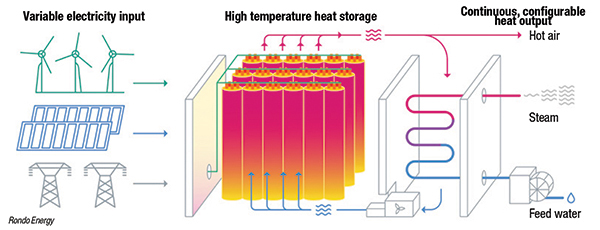As the cost of renewable energy decreases, many organizations are looking to electrify their operations to reduce carbon emissions. One promising area for decarbonization is industrial heating, which accounts for a large fraction of global emissions. However, heating networks in plants can be very complex, making modifications to existing configurations extremely costly.

Now, a new “heat battery” developed by Rondo Energy, Inc. (Oakland, Calif.; www.rondo.energy) aims to provide affordable, decarbonized process heat in a drop-in module that can be easily integrated into an existing boiler network, either to replace aging boilers or to complement those still in operation. “We found a way to use well-proven materials in a new combination to build a heat battery that uses renewable electricity to deliver high-temperature heat by circulating air through a solid material to deliver hot air or high-pressure steam at any condition,” explains John O’Donnell, CEO of Rondo Energy. To meet the safety requirements of industrial plants, Rondo’s technology does not depend on combustion or phase change, and with its low-cost solid heating media, there is no possibility of gas or liquid being released. “The units are safe and compact, and can tie into existing facilities the same way that existing gas- or coal-fired boilers do today,” adds O’Donnell. Furthermore, Rondo’s system can achieve very high temperatures (up to 1,000°C), whereas energy-storage systems that employ liquid salts may only reach 570°C, which limits their use for industrial applications.
The company expects to announce its first commercial installations later this year and was recently awarded $22 million in Series A funding. “We’ve made the transition from the laboratory to prototypes to first field installations. These units are now industrial scale — the standard unit delivers 20 MW of steam, which is like a boiler that’s burning 85 million Btu/h,” says O’Donnell. Furthermore, because the units are equipped with both conventional and dynamic outer insulation layers, heat losses are minimized, resulting in a 98% heat-delivery efficiency.